The figure shows a schematic of an easy to build FM transmitter circuit. Mostly all FM transmitter circuits you will find online or in books require some kind of hand build inductor/coil and after building the transmitter you have to adjust that coil and trimmer capacitor a little to adjust the transmitter to transmit on your desired frequency.
If you are looking for an easy or simple FM transmitter circuit in which you don't have to make a coil with your hand then the circuit given here is ideal for you. The circuit is using a ready made 1uH inductor which can be purchased from an electronic components store. These inductors are mostly look like resistors. The circuit also does not require a trimmer capacitor, because we have used a fixed value of 39pF capacitor in the place of trimmer capacitor. We have already calculated and used the values of coil and capacitors of oscillator to broadcast on FM band, so you don't have to do any further adjustments and tuning after building the circuit. The circuit can be operated with 9 to 12 volt DC. For antenna use a 12 inch wire or for maximum range use a 30 inch wire and make it vertical.
Posted on Monday, July 28, 2014 • Category:
Test and Measurement
Curious C-Beeper is a fun to build little probe that can be used to quickly detect the capacity of capacitors in pF nF range, test their stability with temperature changes, find broken wires, locate wires, trace wires on PCBs, and to locate live wires behind the walls without touching them. The circuit uses three transistors to make a most unusual capacitance beeper probe. When a capacitor is touched to the probe, the probe beeps at a frequency that varies with capacitance. The frequency change is so steep with capacitance that tiny capacitors may be precisely matched or an exact fixed value may be selected to replace a trimmer in a prototype. If the user has reasonably moist skin, simply holding one lead of the capacitor to be tested while touching the other lead to the probe is all that is necessary. The user's body forms the other connection through the beeper's metal case. When the beeper is properly adjusted it draws only 10 uA with nothing touching the probe - no power switch is required. This design is optimized for capacitors less than about 0.1 uF (100 nF). Large capacitors give a low frequency "clicking" sound and small capacitors sound a tone that increases as the capacitance decreases. Many decades of frequency change occur over the beeper's range giving even the more tone-deaf among us sufficient change to discern slight differences in capacitance. The entire device is powered by two CR2032 lithium cells that fit into TicTac box. The use of power switch is unnecessary since the circuit consumes almost no power when not being used.
Posted on Thursday, July 24, 2014 • Category:
Miscellaneous
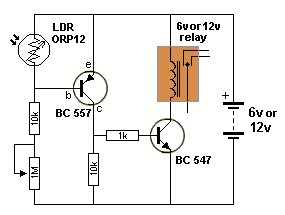
This circuit automatically turns on the light through a relay when daylight intensity falls below a preset level on the Light Dependent Resistor (LDR).
Posted on Tuesday, July 1, 2014 • Category:
Amplifiers
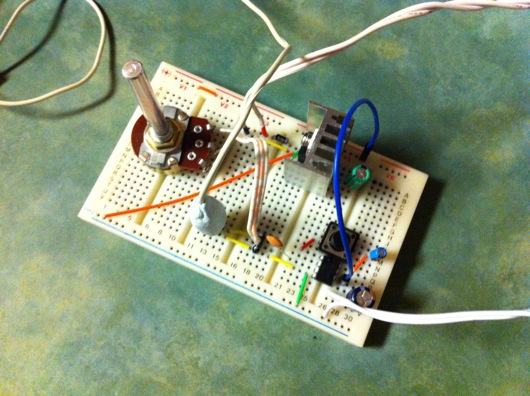
It's always handy to have a little amp kicking around to trace audio signals, test mics, CD tape and TV audio outputs. You know, something that doesn't weigh a lot and isn't clumsy. There are tons of uses for this little circuit.
There are a couple of versions of this amplifier chip. Both are 8 pin DIP packages and the difference between the two are apparent by their part numbers. Either are suited for this circuit provided the supply voltage does not exceed the recommended 5 to 12 volt DC range. Power output can range from about 325 mW to about 750 mW within this supply range when using an 8 ohm speaker. Power it with batteries or a small DC supply...why not solar cells or a little windmill generator?
Posted on Friday, June 27, 2014 • Category:
FM Transmitters
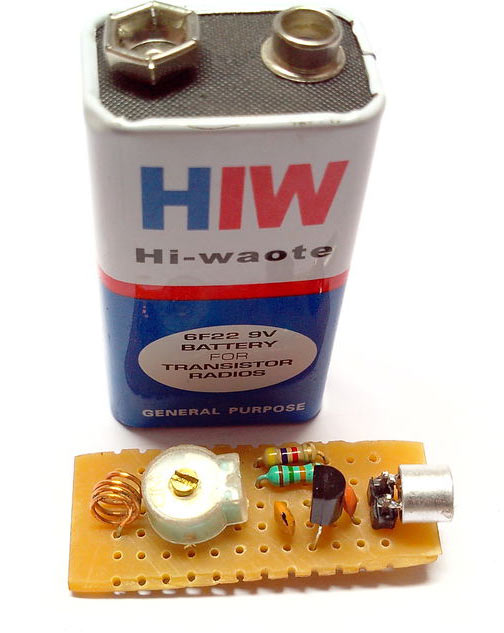
Here's how to build your own mini FM transmitter. It transmits FM waves so you could easily receive the signals on your mobile phone, radios, etc. As the name and the picture indicates it is very small and is approximately the size of a 9v battery clip. With this FM transmitter you could start your own mini FM station. The circuit uses BC547 transistor to amplify the signal and then frequency modulate it. It uses "frequency modulation" most commonly known as FM, the same principal to transmit audio signals captured by the microphone.
Posted on Sunday, June 22, 2014 • Category:
Miscellaneous
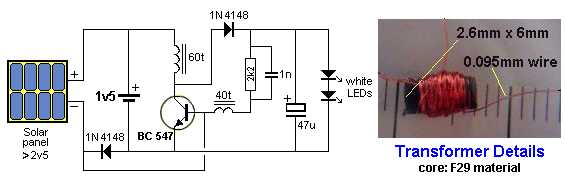
This circuit automatically turns on and illuminates the LEDs when the solar panel does not detect any light. It switches off when the solar panel produces more than 1v and charges the battery when the panel produces more than 1.5v + 0.6v = 2.1v.
Posted on Friday, June 20, 2014 • Category:
USB Circuts

This project is able to power a USB device using two standard AA batteries and an electronics circuit. The circuit is based on LT1073 DC/DC converter to convert the 3V to 5V needed by USB. In that way it can power the USB device on the go.
Posted on Sunday, June 15, 2014 • Category:
FM Transmitters
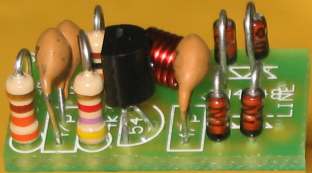
This small phone transmitter will transmit a phone conversation to an FM radio on the 88-108MHz band. It uses energy from the phone line to transmit the signal about 100 meters away. It uses the phone wire as the antenna and is activated when the phone is picked up. Transmitter components are mounted on a small PC board. PC layout is included.
Posted on Friday, June 6, 2014 • Category:
FM Transmitters
This classic walkie talkie consists of both 27MHz transmitter and receiver all in one circuit. Nearly all the components in the 4-transistor circuit are used for both transmitting and receiving making it simple to build and economical at the same time. The frequency-generating stage only needs 27MHz crystal to be removed and it becomes a receiver. Next is a three transistor audio amplifier with very high gain. The first transistor is a pre-amplifier and the next two are wired as a super-alpha pair, commonly called a Darlington pair to drive the speaker that is also used as a microphone. The use of telescopic antenna will provide better reception and transmitting range. Use two identical walkie talkie circuits for two way communication.
Circuit-Zone.com © 2007-2025. All Rights Reserved.